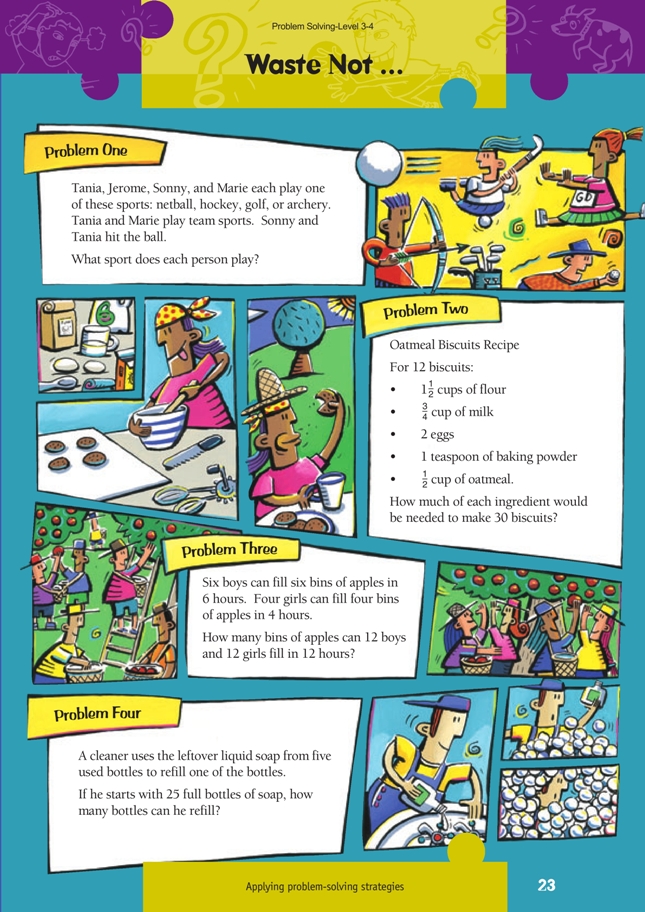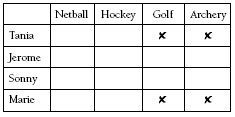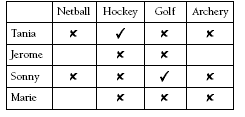These are level 3 probability and level 4 number problems from the Figure It Out series.
A PDF of the student activity is included.
Click on the image to enlarge it. Click again to close. Download PDF (380 KB)
find outcomes using diagrams (Problem 1)
solve problems involving simple proportions (Problem 2 and 3)
Problem One
Drawing a table and working through the clues systematically to eliminate possibilities is a good way to solve this problem. Put an X in a square where the person doesn’t play the game. Tania and Marie play team sports, so put an X against them in the golf and archery columns.
Sonny and Tania hit the ball, which eliminates netball and archery for both of them. There is now only one space left in Tania’s row, so she must play hockey. As a result, no one else can play hockey, and Sonny must play golf.
This shows that Marie plays netball and Jerome must be the archer.
See also Problem Four, page 16, in Problem Solving, Figure It Out, Level 3.
Problem Two
In this problem, the students need to work out how many times 12 goes into 30. 30 ÷ 12 = 5/2. Multiply the amount of each ingredient by 5/2, as shown below.
Flour: 11/2 x 5/2 = 3/2 x 5/2 = 15/4 = 3 3/4 cups
Milk: 3/4 x 5/2 = 15/8 = 1 7/8 cups
Eggs: 2 x 5/2 = 5
Baking powder: 1 x 5/2 = 5/2 = 21/2 teaspoons
Oatmeal: 1/2 x 5/2 = 5/4 = 11/4 cups.
Problem Three
Ensure that the students read this problem carefully. It’s easy to make the mistake of assuming that one boy can fill one bin in 1 hour, two boys can fill two bins in 2 hours, three boys can fill three bins in 3 hours, and so on. This is not correct.
If six boys can fill six bins in 6 hours, they can fill 12 bins in 12 hours and 12 boys can fill twice as much in the same time. So 12 boys can fill 24 bins in 12 hours.
If four girls can fill four bins in 4 hours, they can fill eight bins in 8 hours and 12 bins in 12 hours.
So eight girls can fill 24 bins in that time and 12 girls can fill 36 bins in that time.
Altogether, 24 + 36 = 60, so 60 bins of apples were filled.
Problem Four
This is another problem that the students have to approach carefully. It’s easy to miss out the last bottle.
If the leftover liquid from five bottles can fill one bottle, then the leftover liquid from 25 bottles can fill five bottles. But the leftover liquid in the five refilled bottles can be used to fill another bottle, so altogether, six bottles were refilled (with a little bit left over).
Hints for Students
1. Make a table.
2. How many times does 12 go into 30?
3. Work through this problem systematically and carefully.
How many bins can six boys fill in 12 hours?
4. You could use equipment or a drawing. Check that you have counted all the bottles.
Answers to Problems
1. Tania: hockey
Jerome: archery
Sonny: golf
Marie: netball
2. 3 3/4 cups of flour, 1 7/8 cups of milk, 5 eggs, 2 1/2 teaspoons of baking powder, 1 1/4 cups of oatmeal
3. 60 bins
4. 6



